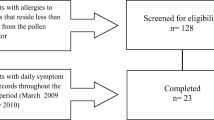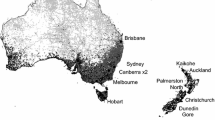Abstract
In Melbourne, Australia, grass pollen is the predominant cause of hayfever in late spring and summer. The grass pollen season has been monitored in Melbourne, using a Burkard spore trap, for 13 years (1975–1981, 1985 and 1991–1997). Total counts for grass pollen were highly variable from one season to the next (approximately 1000 to >8000 grains/m3). The daily grass pollen counts also showed a high variability (0 to approximately 400 grains/m3). In this study, the grass pollen counts of the 13 years (12 grass pollen seasons, extending from October to January) have been compared with meteorological data in order to identify the conditions that can determine the daily amounts of grass pollen in the air. It was found that the seasonal total of grass pollen was directly correlated with the rainfall sum of the preceding 12 months (1 September–31 August): seasonal total of grass pollen (counts/m3)=18.161 × rainfall sum of the preceding 12 months (mm) −8541.5 (r s=0.74,P<0.005,n=12). The daily amounts of grass pollen in the air were positively correlated with the corresponding daily average ambient temperatures (P<0.001). The daily amount of grass pollen which was to be expected with a certain daily average temperature was linked to the seasonal total of grass pollen: in years with high total grass pollen counts, a lower daily average temperature was required for a high daily pollen count than in years with low total grass pollen counts. As the concentration of airborne grass pollen determines the severity of hayfever in sensitive patients, an estimation of daily grass pollen counts can provide an indication of potential pollinosis symptoms. We compared daily grass pollen counts with the reported symptomatic responses of hayfever sufferers in November 1985 and found that hayfever symptoms were significantly correlated to the grass pollen counts (P<0.001 for nasal,P<0.005 for eye symptoms). Thus, a combination of meteorological information (i.e. rainfall and temperature) allows for an estimation of the potential daily pollinosis symptoms during the grass pollen season. Here we propose a symptom estimation chart, allowing a quick prediction of eye and nasal symptoms that are likely to occur as a result of variations in meteorological conditions, thus enabling both physicians and patients to take appropriate avoidance measures or therapy.
Similar content being viewed by others
References
Antepara I, Fernandez JC, Gamboa P, Jauregui I, Miguel F. Pollen allergy in the Bilbao area (European Atlantic seaboard climate): pollination forecasting methods. Clin Exp Allergy 1995;25:133–40.
Davies RR, Smith LP. Forecasting the start and severity of the hay fever season. Clin Allergy 1973;3:263–7.
Freidhoff LR, Ehrlich-Kautzky E, Grant JH, Meyers DA, Marsh DG. A study of the human response toLolium perenne (rye) pollen and its components, Lol p 1 and Lol p 2 (rye I and rye II). J Allergy Clin Immunol 1986;78:1190–201.
Grote M, Dolecek C, Van Ree R, Valenta R. Immunogold electron microscopic localization of timothy grass (Phleum pratense) pollen major allergens Phl p I and Phl p V after anhydrous fixation in acrolein vapor. J Histochem Cytochem 1994;42:427–31.
Hill DJ, Smart IJ, Knox RB. Childhood asthma and grass pollen aerobiology in Melbourne. Med J Aust 1979;1:426–9.
Hyde HA. Atmospheric pollen and spores in relation to allergy. Clin Allergy 1972;2:153–79.
Lejoly-Gabriel M. Recherches écologiques sur la pluie pollinique en Belgique. Acta Geogr Lovan 1978;13:1–260.
Ong EK, Singh MB, Knox RB. Aeroallergens of plant origin: molecular and aerobiological significance. Aerobiologia 1995;11:219–29.
Ong EK, Taylor PE, Knox RB. Forecasting the onset of the grass pollen season in Melbourne (Australia). Aerobiologia 1997;13:43–8.
Rantio-Lehtimäki A, Koivikko A, Kupias R, Makinen Y, Pohjola A. Significance of sampling height of airborne particles for aerobiological information. Allergy 1991;46:68–76.
Recio M, Cabezudo B, Del Mar Trigo M, Toro FJ. Accumulative air temperature as a predicting parameter for daily airborne olive pollen (Olea europea L.) during the pre-peak period in Malaga (Western Mediterranean area). Grana 1997;36:44–8.
Schäppi GF, Monn C, Wüthrich B, Wanner HU. Direct determination of allergens in ambient aerosols: methodological aspects. Int Arch Allergy Immunol 1996;110:364–70.
Smart IJ, Knox RB. Aerobiology of grass pollen in the city atmosphere of Melbourne: quantitative analysis of seasonal and diurnal changes. Aust J Bot 1979;27:317–31.
Smart IJ, Tuddenham WG, Knox RB. Aerobiology of grass pollen in the city atmosphere of Melbourne: effects of weather parameters and pollen sources. Aust J Bot 1979;27:333–42.
Spieksma FThM, Van den Assem AD, Collette BJA. Airborne pollen concentrations in Leiden, The Netherlands, 1977–1981. II. Poaceae (grasses), variations and relations to hayfever. Grana 1985;24:99–108.
Spieksma FThM, Kramps JA, Van der Linden AC. Evidence of grass pollen allergenic activity in the smaller micronic atmospheric aerosol fraction. Clin Exp Allergy 1990;20:273–80.
Suphioglu C, Singh MB, Taylor P, Bellomo R, Holmes P, Puy R, Knox RB. Mechanism of grass pollen induced asthma. Lancet 1992;339:569–72.
Valenta R, Vrtala S, Ebner C, Kraft D, Scheiner O. Diagnosis of grass pollen allergy with recombinant timothy grass (Phleum pratense) pollen allergens. Int Arch Allergy Immunol 1993;97:287–94.
Author information
Authors and Affiliations
Corresponding author
Rights and permissions
About this article
Cite this article
Schäppi, G.F., Taylor, P.E., Kenrick, J. et al. Predicting the grass pollen count from meteorological data with regard to estimating the severity of hayfever symptoms in Melbourne (Australia). Aerobiologia 14, 29–37 (1998). https://doi.org/10.1007/BF02694592
Received:
Accepted:
Issue Date:
DOI: https://doi.org/10.1007/BF02694592




